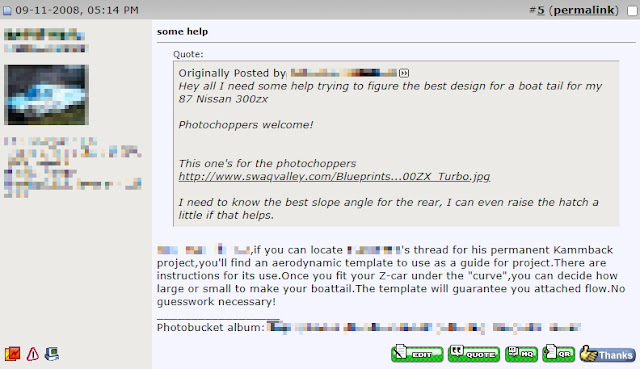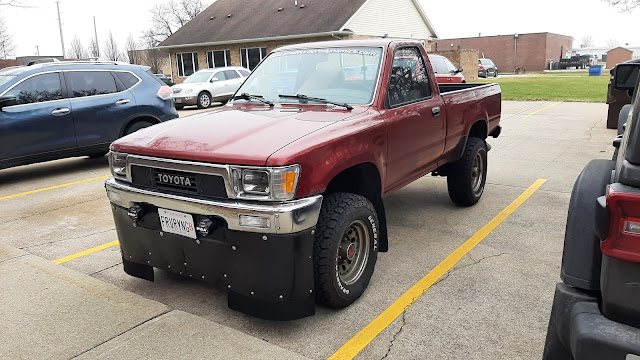Testing is an Absolute Necessity, Not an Unnecessary Frivolity
The claim: Since we know what the “ideal”
shape looks like and can predict airflow over a car, all we have to do is build
something to that shape and it will be guaranteed to work. There’s no
need to test anything.
 |
| Eliminating guesswork by...more guessing. Sounds legit. |
The reality: Because of the complexity of the
flow around a car, “automobile aerodynamics is still dominated by empiricism,”
as Hucho wrote in Aerodynamics of Road Vehicles.
Simulations have replaced some of the development previously done in wind
tunnels as computers have become more powerful and faster, but there is still
no way (and likely never will be) to design a low-drag car by following simple
principles of shaping such as the “template” discussed previously, despite
aerodynamicists searching for one for the past half century. In real life, it
simply doesn’t work; the flow around cars is too complex. Yet scads of people
frequenting online forums spend a great deal of time and effort building
aerodynamic devices or structures on their cars based on the idea that a little
theory is enough to go on. Due to fear of discovering the devices don’t work as
they intended or lack of knowledge of any reliable test techniques or both,
they rarely if ever bother to verify that these devices do what they claim or
they use techniques that are not reliable or sensitive enough to indicate a
change in aerodynamic force with any confidence.
 |
| Like this. |
I happen to think now that it’s mostly people afraid of
being wrong, in addition to simply not knowing any better because they have
been fed a steady stream of simplified “template” BS everywhere they’ve looked
for advice online (this was certainly my experience). Julian Edgar, the
Australian author, journalist, and former editor of Autospeed,
inadvertently provided an example of this when he joined a well-known web forum
before publishing a new book on aerodynamic testing for amateur modifiers. Edgar codified some existing testing techniques and developed groundbreaking
new ones and shared them on the forum; almost
immediately, a cadre of posters, led by one in particular who was seen as some
sort of aerodynamic guru (and the developer of a two-dimensional “template”
based on the Klemperer/Jaray model), jumped down his throat. They simply could
not believe that actual, on-road testing of aerodynamic changes to a car
could be more reliable than predictions based on the “template.” The
vitriol with which they defended their approach—which is essentially one of
guessing and hoping—betrayed their dogmatism. Belief in the “template” was just
that; one poster even used that word to describe his support of it.
That’s a pity, because the community at this well-known web
forum is made up of just the sort of people who would benefit from testing new
aerodynamic devices to reduce drag, would likely learn a lot from it, would be
much more credible with measured and documented improvements that they could
share, and could pass a lot of this knowledge on to others since they have a
tendency to evangelize. Yet, visit the forum today and you will still see most
of the posters content to sit and speculate, to compare production and concept
cars to the “template” (based on the center profile cautioned against by
Barnard and others), and to devote energy and resources to constructing
aerodynamic add-ons based solely on it. One of them has even dressed up these
profile comparisons, calling them “dimensional analysis”—which in this case is
just a fancy way of saying “looking at the shapes” (don’t confuse this with actual
dimensional analysis, which is a method in fluid mechanics “for reducing the
number and complexity of experimental variables that affect a given physical
phenomenon,” as explained by Frank White in Fluid Mechanics, 2017). The
problem with this pseudo-“dimensional analysis” is it doesn’t tell you anything
useful about what the air does around that shape (especially if you’re
looking only at a center profile); the only way to do that is by measurement,
whether in a wind tunnel or a computer simulation or on the road.
 |
| Above: measuring things. Here, I was recording pressures on the side of my car with and without ducts ahead of the wheels. |
And now, thanks mostly to the efforts of Edgar, we have a
lot of ways to measure things on the road. Useful techniques such as wool tuft
testing for flow visualization and pressure measurement on body panels already
existed, but Edgar also came up with an entirely new method for measuring
changes in drag directly: throttle-stop testing. Since a
car will reach its top speed when the power required to overcome mechanical and
aerodynamic drag matches the engine’s output, he reasoned, artificially
limiting engine power temporarily should allow the measurement of drag changes
at legal speeds on the road. Simply place a stop on the throttle to fix its
travel, make an aerodynamic change to the body, and compare the speeds reached;
if the speed goes up, drag has been reduced; if it goes down, drag has been
increased. The method is simple, reliable, and cheap.
This has been anathema to the armchair aerodynamicists on
the web, however. Edgar’s thread on throttle-stop testing received 8,700 views
and garnered more than a hundred replies—yet only three people reported trying
it out. Even fewer attempted measuring body panel pressures on the road. More
than a decade of unchallenged “template” theory had poisoned the waters,
generating a cult-like belief in the practice of “guess and hope” rather than
test and measure. The fact that testing and measurement is exactly what every
textbook on vehicle aerodynamics prescribes is apparently lost on all these
hobbyists. Scibor-Rylski commented on the importance of testing: “Our
accumulated experience and know-how of car aerodynamics is gathered from many
scale models tested in wind tunnels and from investigations on full-sized
vehicles carrying measuring equipment which are tested on the road under
natural conditions.” What a shame that a huge part of the hobbyist community
interested in aerodynamics won’t do it simply because they don’t believe it
necessary, even as they idolize shapes that were produced through testing.
I understand that testing can seem daunting. It also seems
like a lot of effort—because it is! It takes a great deal of thought and
planning, time finding a suitable testing location and waiting for good
weather, energy to make temporary mockups and figure out how you’re going to
test them, and consternation interpreting the results. I get it. But the rewards
far outweigh the effort, and in the end, testing is far more satisfying than
shooting from the hip and hoping your guesses are working, never knowing if
they are or not. Who on earth wants to live like that? There’s no need to
premise aerodynamic modifications to your car on a belief that they work
when you can, for the cost of some cheap supplies and a little bit of time, know
that they work.
 |
| Initial testing of fins, made quickly out of cheap corrugated plastic and taped in place. Tuft testing didn't tell me anything useful, so I'll test them again using a different method such as pressure measurement. |
Kent Kelly and Harry Holcombe, two GM stylists, wrote in a
1963 paper, “Technical apathy is often a far greater deterrent to the
acquisition and application of vehicle aerodynamic data than any excessive
expenditures of time or money.” That is certainly still true today.







Comments
Post a Comment